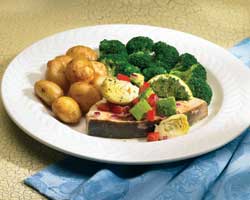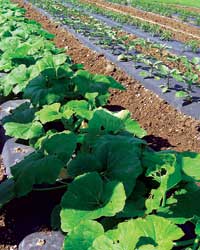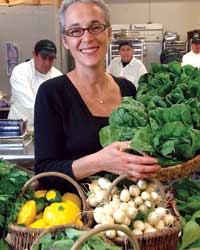
As cold weather creeps in, domestically grown fruits and vegetables begin to dwindle.

Don’t get left out in the cold
While states like California, Arizona and Florida harvest crops all year round, the pickings are slim in other parts of the country. But there are several other options for produce-seeking operators and their customers. Imports from South America, Mexico and warmer climes have increased in quantity, quality and variety in the last few years. The same goes for frozen and processed fruits and vegetables. Even restaurants that are keeping track of “food miles”—the distance produce travels from farm to table—are finding fresh ingredients closer to home, thanks to creative growing techniques and increased demand. The ground may be covered with snow but your produce purchasing dollars can go beyond root vegetables and apples held in storage.
Freshen up
The key to purchasing winter produce is to remain flexible,” says Lloyd Ligier, VP of business development for ProAct, a global procurer and distributor. “If head lettuce takes a bad hit from the weather, substitute romaine.” ProAct sends out commodity market reports twice a week to update customers on weather conditions, supply, transportation issues and prices for over 25 fruits and vegetables. In winter, ProAct sources about 90 percent of its vegetables domestically and 10 percent as imports; on the fruit side, the ratio is 70 percent to 30 percent.

Mimi's Swordfish With Artichoke-Avocado Salsa
Without imports, most mainstream restaurants would have a hard time keeping signature dishes on the menu. “A fruit or vegetable goes on almost every plate and 95 percent of our produce purchases are fresh,” reports Chris Young, assistant director of purchasing for the Tustin, California-based Mimi’s Café. Top buys are melons, avocados, romaine and green leaf lettuce, tomatoes and broccoli. “To keep items consistent, we have to use imported produce—fruit from Chile, tomatoes from Mexico and asparagus from Peru.”
Young works through one produce distributor who contracts with growers and suppliers in each region where Mimi’s has locations. Contracts are negotiated on an annual basis to meet Mimi’s specs and lock in prices. Over the next 12 months, Young is paying two to three percent more than she did last year. She blames the increase on bad weather conditions, bug infestation and stricter safety regulations.
“The industry is pouring enormous amounts of money into safety,” Ligier agrees. Traceability has become a priority in light of recent E-coli and salmonella outbreaks. Currently, distributors are investing in tracking technology and food safety certification to monitor the supply chain; growers and shippers are also spending on safety. Eventually, operators are going to have to absorb more of these costs, Ligier contends.

Katchkie Farm in Upstate New York
The local route
While most operators have a fairly easy time procuring local, seasonal produce in spring, summer and fall, it’s a challenge in the winter. Liz Neumark, founder and CEO of Great Performances, a company that operates several cafes and foodservice venues in New York City, has found a way around supply limitations.
She grows her own.
In the summer of 2006, Neumark established Katchkie Farm in New York’s upstate Hudson Valley. The 60-acre sustainable, year-round organic farming operation can deliver fresh produce to her concepts 24 to 48 hours after harvest. During this first growing season, the fields yielded 29 different vegetables and an assortment of herbs.
Although frost hardens the ground by November, items like butternut squash, turnips and onions are plucked and placed in cold storage. Plus, Neumark prolongs the season by preserving: Heirloom tomatoes are roasted and frozen; beets and cucumbers are pickled and winter squash is cured. And for the first time this winter, Katchkie’s three greenhouses will be providing enough arugula, mache, spinach, mustard greens, herbs and other leafy treats to freshen up the menu.

Liz Neumark Reaps Farm-Fresh Rewards
“It’s very impactful in the middle of January to surprise guests with flavorful greens,” Neumark says. Yet Great Performances is not on a mission to be local and sustainable year round. “New Yorkers expect more variety. They won’t settle for lentil and bean soup all winter—they want their asparagus soup too,” she adds.
For operators who can’t swing their own farm, Neumark suggests setting up a custom growing arrangement. “Get involved with a farmer in the winter and have him or her commit acreage to your restaurant for a steady supply of vegetables.”
Winter sourcing strategies
- Watch the weather. Fresh produce is at the mercy of winter weather and prices can fluctuate from week to week, points out Gary Lucier, USDA vegetable market analyst.
- Buy from a produce specialist. Broadliners are okay with commodities like potatoes and onions, but a distributor who focuses on fresh produce works closely with growers and shippers to get you top quality and variety at the best price.
- Arrange frequent deliveries. Although winter produce is hardier, flavor is better when it doesn’t sit too long in storage.
- Be strict about traceability. Make sure your distributor can track fruits and vegetables from the field to your back door.
- Integrate frozen and processed into the mix. When you can’t get fresh fruits and vegetables in season, opt for IQF frozen and minimally processed or all-natural canned.
Market Report
Winter 2007 saw some wild weather in key produce-growing regions. Subfreezing temperatures in California and Arizona damaged or disrupted several crops, including oranges, artichokes, head lettuce, broccoli and leafy greens. For the most part, the supply has rebounded or increased slightly and prices have declined, but immature plants that were harmed by the freeze may bring some shortages and price spikes this fall. If no freezes occur this season, last year’s strong wholesale prices could go lower, says Gary Lucier, vegetable market analyst with the USDA’s Economic Research Service.
“Weather is a big ‘if.’ Crucifers [broccoli and cabbage, for example] and leafy crops can stand a little chill, but citrus and tomatoes get destroyed by the cold,” Lucier explains. “Right now, it’s hard to make projections, but it looks like costs for all vegetables will remain a bit higher although not hugely so.” Other forces are also affecting fresh produce prices, he adds. There’s a greater worldwide demand for American-grown vegetables, and growers find it more profitable to export. Plus, commodities like corn, wheat and soybeans—all at record prices—are setting the pace for some processing vegetables, including tomatoes, corn and snap beans.
Here’s a run-down on selected winter staples, based on USDA analysis:
Processing tomatoes: Strong wholesale prices spurred a 4 percent larger area to be planted this year. If favorable growing conditions prevail, good-sized crops are expected, along with a stabilization of prices.
Potatoes: Both white and sweet potatoes are in ample supply, slightly above last year’s figures. Interest from overseas is fueling demand.
Mushrooms: Demand pushed sales up 7 percent in 2007 and output for 2007-08 is expected to increase.
Onions: Supply has increased and prices have weakened since last spring’s highs but should remain above long-term averages.
Safety update
Food safety has become the priority for everyone in the produce supply chain, from the grower down to the end user. Three pros—from distribution, restaurant purchasing and farming—talk about how their operations have changed as safety has become a greater concern.
Lloyd Ligier, ProAct
When there’s an outbreak from contaminated produce, the first call I get from operators is “did any of my restaurants get the tainted product?” By bar coding cartons of produce, we track back to the grower, shipper, warehouse and delivery truck. Third party audits take place at these points but we have no control over what happens if the produce comes from a terminal market. By the end of 2008, ProAct is mandating identification of the origin and destination of every box of produce from every one of our distribution points. Although we’ll still be using bar codes, eventually chips will go into the cartons right at the field. Test and hold facilities are another innovation. Instead of releasing produce immediately only to have it be recalled in certain cases, new methodology is in place to test and hold it under controlled conditions.
Chris Young, Mimi’s Café
We unload the cases at our refrigerated docks, checking the temperature of the sealed truck and each carton. The produce is then unpacked and transferred to plastic bins along with the bar code and lot number from its packing carton; these are kept together until the product is completely used up. The bins are rotated in the walk-in, first in, first out. We’ve also put a more progressive cleaning system in place. All produce is now triple washed in a sanitizing solution in-house. Employees in every one of our 120 stores have to follow stringent cleaning and prepping specs.
Liz Neumark, Katchkie Farm
Small farmers and farmer’s markets are often criticized for not complying with the same safety standards and good agricultural practices as bigger producers. But we can’t afford to make mistakes—if we’re not very vigilant, we can easily go out of business. Operators who are doing business with local farmers need to forge tight relationships. Visit the farm and check out the property surrounding the growing areas. Make sure the farmer isn’t taking any shortcuts with sanitation or safety. We’ve recently put a lot of energy into creating a safe, reliable delivery system.
Q&A with Sheri Miksa, President and CEO, Robeks
Manhattan Beach, California-based
As a produce-focused concept, how do you manage with the more limited winter supply?
Our menu is designed to work around seasonal shortages. Many options use year-round fruits and vegetables, like our popular ABC—a blend of freshly extracted apple, beet and carrot juices. We also get wheat grass from a local supplier all winter and fresh bananas are always available. To augment bananas in our smoothies and shakes, we purchase quick-frozen fruit. IQF pineapple, mango and berries are close to fresh in flavor and nutrients and offer great consistency.
Are you planning any seasonal specials this winter?
We’re introducing a Pump It Up Pumpkin Smoothie as an LTO. It’s a great winter product—pumpkin pie taste and the health benefits of beta carotene in a soymilk-based smoothie. The item uses canned pumpkin, which works out well distribution-wise; it’s convenient and easy to procure.
What produce purchasing challenges are you facing now?
Commodity price pressures are a major challenge. With more Americans focusing on health, the demand for healthy menu items is greater than ever and that drives up fruit and vegetable pricing. Weather is also impacting produce costs.
How are you meeting this challenge?
We use a number of distributors around the country who work with growers and suppliers that deliver the best quality for the best price. Out of 127 locations, we have one company store and the rest are franchises, so we have to keep a close watch on costs. We also keep a watch on the quality of our distributors, choosing those who are scrupulous about supply chain safety and sanitation.
Members help make our journalism possible. Become a Restaurant Business member today and unlock exclusive benefits, including unlimited access to all of our content. Sign up here.